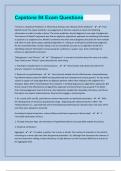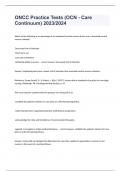Exam (elaborations)
Capstone 84 Exam Questions Correctly Solved|2024
- Course
- Institution
Clinical vs. Statistical Prediction: A Theoretical Analysis and a Review of the Evidence" - ️️Paul Meehl's book; The major predicate: any judgement or decision requires a means of combining information in order to make a choice. The minor predicate: clinical diagnosis is one type of judgement. ...
[Show more]




